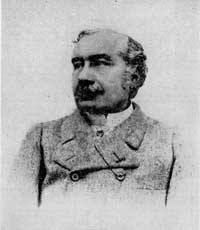Paul Émile Lecoq de Boisbaudran
Paul Émile (François) Lecoq de Boisbaudran (born April 18, 1838 in Cognac , † May 28, 1912 in Paris ) was a French chemist who discovered the chemical element gallium in his private laboratory in 1875 .
life and work
The son of a family of wine merchants grew up in an atmosphere characterized by friendliness, mutual respect and personal responsibility. His mother taught him foreign languages and history. In self-study, using teaching materials from the École polytechnique , he acquired a solid basic knowledge of chemistry and physics. With the help of his uncle, he set up a private laboratory in which, in addition to his work in his parents' company, he carried out various experiments.
Boisbaudran quickly became known and a recognized authority through his physical-chemical work in the field of spark spectroscopy , developed by Gustav Robert Kirchhoff and Robert Wilhelm Bunsen (1859) . He developed a theory about the relationship between the frequency of the spectral lines and the atomic mass of a chemical element. On the basis of missing lines in the spectrum of aluminum and indium compounds , he tried early on to find a previously unknown element that could be classified between the two elements. But his first attempts failed because of the small amount of the isolated substance. According to Boisbaudran, Boisbaudran did not learn anything about the prediction of this element, initially called Eka-Aluminum , by Mendeleev in 1871. So he took his time with the further equipment of his laboratory and only began in 1874 with the processing of 54 kg of a zinc blende (zinc ore) from Pierrefitte in the Pyrenees , which he had procured in 1868. In September 1875 he was able to detect the element he was looking for for the first time using a spectral line. In the same month he traveled to Paris and demonstrated his new element in Charles Adolphe Wurtz's laboratory . Here he met Charles Friedel , among others . The new element was named "Gallium" after the ancient name Gaul for Boisbaudran's native France. In November, Boisbaudran succeeded for the first time in producing metallic gallium by electrolysis of an ammoniacal gallium sulfate solution. After a short time he had produced a sufficient quantity of substance to determine the physical properties. In 1876 he worked with his colleague Émile Jungfleisch on four tons of zinc blende and extracted 75 g of metallic gallium from it.
Later Boisbaudran turned to the metals of the rare earths and discovered the elements samarium in samarskite (1879) and dysprosium in holmium earth (1886). After 1895 he was unable to carry out any experimental work because of an ankylosis (joint stiffening).
In 1878 he was accepted as a corresponding member of the Académie des sciences .
Fonts
- Specters lumineux: specters prismatiques et en longueurs d'ondes destinés aux recherches de chimie minérale . Gauthier-Villars, Paris 1874
Awards
- "Prix Bordin" of the Academy of Sciences (1872),
- the award of the Légion d'Honneur ( Legion of Honor ) à la Sorbonne (1876),
- les palmes académiques (academic palm),
- le titre de correspondant de l'institut (June 10, 1878),
- Grand Prix of the World Exhibition of 1878
- Davy Medal of the Royal Society in London (1879)
- the “prix Lacaze” endowed with 10,000 francs by the Academy of Sciences (1880)
literature
- Mary Elvira Weeks: Discovery of the Elements . 3rd edition, Kessinger Publishing, 2003, ISBN 978-0-7661-3872-8 , pp. 215-219.
Individual evidence
- ^ List of members since 1666: Letter L. Académie des sciences, accessed on January 11, 2020 (French).
| personal data | |
|---|---|
| SURNAME | Lecoq de Boisbaudran, Paul Émile |
| ALTERNATIVE NAMES | Lecoq de Boisbaudran, Paul Émile François (full name) |
| BRIEF DESCRIPTION | French chemist |
| DATE OF BIRTH | April 18, 1838 |
| PLACE OF BIRTH | cognac |
| DATE OF DEATH | May 28, 1912 |
| Place of death | Paris |
